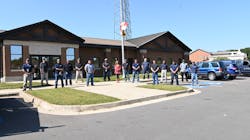Seneca WRRF earns WEF Project Excellence Award
Water Environment Federation awarded WSSC Water Seneca Water Resource Recovery Facility (WRRF) the Project Excellence award for implementing efficient plant optimizations.
The Seneca WRRF facility in Montgomery County, Maryland, used ammonia-based aeration along with reduced pumping for nutrient removal — primarily nitrogen and phosphorus. Through this process, the facility reduced its chemical and energy costs, saving approximately $575,000 annually while also reducing its carbon footprint.
What is Ammonia-Based Aeration?
Caroline Nguyen, WSSC Water principal scientist, said ammonia-based aeration uses online ammonia sensors to better dose oxygen for aeration with less overall waste in both energy and air.
“During the wastewater treatment process, instead of setting the dissolved oxygen (DO) concentration in the aerated zones (e.g., 2 mg/L DO) and adding excess air to the process, we can use feedback from an online ammonia sensor to automatically provide just the right amount of air needed for the ammonia removal (which is the primary measurable target in the aerobic zones),” Nguyen said. “We ended up using 30 to 40% less air in the aerobic zones; operated at a low average DO of about 0.3 mg/L instead of 2 mg/L; and achieved more efficient nitrogen removal (meeting low nitrogen and phosphorus limits with less energy and chemicals).”
Researching the Ammonia Removal Process
WSSC Water landed on this approach after working with Brown and Caldwell and Northwestern University to research the process through Water Research Foundation. Nguyen said the facility used existing ammonia sensors to monitor the ammonia in the system while testing how much air to introduce into the aerobic zones. Through this data, they were able to identify the precise amount of air to remove the ammonia.
“We can see from the data that instead of getting all of the ammonia removal in the very first part of the aerobic zone, we spread out the removal throughout the aerobic zones and get more simultaneous nitrification and denitrification within the aerobic zones,” Nguyen said. “We normally need dedicated aerobic zones for nitrification and dedicated anoxic (no air) zones for denitrification. Our WRRFs use a lot of chemicals and energy to meet very low nitrogen and phosphorus limits, so this mode of operation results in huge energy and chemical savings.”
The research, she added, coud be applied to other WRRFs, not just the Seneca facility. In fact, she said they are also interested in researching where they can use “even more efficient anammox bacteria within the mainstream process.” Determining the type of nitrogen controls, she added, would be another element of that exploratory effort.
Lessons Learned & Future Opportunities
The big takeaway, Nguyen said, was how far they could push the optimization of the system to net big savings. Implementing the aeration changes presented some challenges, namely in training operators and in updating all the controls, aerobic zones and pump speeds to fulfill the new process. After a year operating in this way, however, Nguyen said the operators are comfortable with how it works and performs.
“There are still some unique limitations, but overall it’s clear that there’s excellent treatment performance even with the limitations. We’re now looking at ways to expand to the rest of the facility and other WSSC Water WRRFs,” she said. “At the national level, there’s growing interest in this idea of aerating and pumping less to keep more of the carbon that comes into the plant around for denitrification instead of needing to add external carbon.”
On that carbon footprint note, she said WSSC Water is committed to reducing its footprint and in reducing greenhouse gas emissions, and even has a GHG Action Plan, which this project was a part of.
“The action plan includes strategies to reduce future GHG emissions at WSSC Water by 10% every five years through the year 2050 for 80% reduction by 2050 relative to the baseline level in 2005, using demonstrated technologies and practices available,” Nguyen said. “This important project is included as one of WSSC Water’s GHG reduction strategies.”
Additional WSSC Water Awards
In addition to the WEF Project Excellence award, WSSC earned the National Association of Clean Water Agencies (NACWA) Peak Performance Award for this project as well. The NACWA Peak Performance Award also recognized other WSSC Water facilities with platinum and gold awards. Platinum awards are earned with five or more years of perfect compliance and gold is awarded when facilities reach 100% compliance within a calendar year. The list of awarded facilities are:
- Damascus WRRF – Platinum, 22nd consecutive year
- Parkway WRRF – Platinum, 16th consecutive year
- Seneca WRRF – Platinum, 16th consecutive year
- Hyattstown WRRF – Platinum, 11th consecutive year
- Western Branch WRRF – Gold, 1st year
In a WSSC Water press release, WSSC Water General Manager Carla Reid said she is proud of her facilities continued efforts toward achieving excellence.
“As the nation celebrates the 50th Anniversary of the Clean Water Act, these awards highlight WSSC Water’s commitment to protecting the health of our rivers, streams and the Chesapeake Bay,” Reid said. “I am extremely proud of the job our plant operators, and staff who work 24/7/365 to ensure we return clean water to our environment.”


